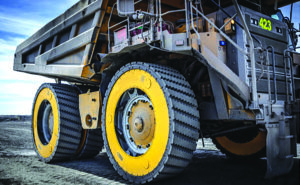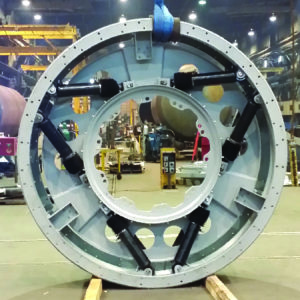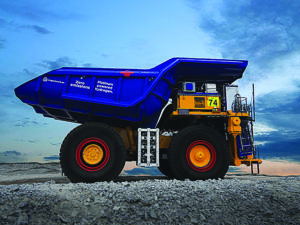
Existing stationary charging solutions are too slow and can’t charge a massive battery-electric powered truck within its haul cycle. The Charge On Innovation Challenge is aimed at attracting both traditional and nontraditional vendors to develop commercializable solutions to the problem.
The Charge On Innovation Challenge, a competition sponsored by BHP, Rio Tinto, Vale and other mining industry patrons interested in accelerating the commercialization of solutions for fast-charging large electric haul trucks, recently chose eight contestants’ submissions for further consideration. The finalists will collaborate with mining companies, OEMs and investors to support the future roll-out of zero-emissions fleets, according to contest sponsors.
The eight finalists include ABB, Ampcontrol and Tritium (Australia), BluVein XL, DB Engineering & Consulting with Echion Technologies, Hitachi Energy, Shell Consortium, Siemens Off-board power supply, and 3ME Technology.
The challenge, launched in 2021, invited vendors and technology innovators to work with the mining industry to present novel electric truck charging solutions. The challenge received interest from more than 350 companies across 19 industries, with more than 80 companies submitting expressions of interest. Twenty-one companies were then invited to present a detailed pitch of their solution. The final eight were chosen from these 21 companies.
GHD, a professional services company, facilitated the Charge On Innovation Challenge and will support the next step — the process of establishing consortia to drive testing of preferred technologies. GHD’s role builds on the work of Austmine to launch the challenge, which attracted a number of supporting organizations, OEMs and investors.
The crux of the challenge is that diesel-powered haul truck fleets are responsible for up to 80% of a mine’s emissions, but electrifying them requires charging systems capable of delivering energy at unprecedented power levels during operations. Here are thumbnail descriptions of the various approaches proposed by the finalists.
ABB said by applying its ABB Ability eMine framework of methods and solutions, it can provide a dual-charging system solution for stationary and in-motion charging that leverages standardized infrastructure and onboard systems and components.
Ampcontrol and Tritium’s mining haul truck battery swap solution is described as an end-to-end, ultra-fast modular recharging station that is fully automated, relocatable, scalable and cell agnostic. In this drive-in/drive-out approach, an autonomous transfer robot swaps batteries in 90 seconds.
BluVeinXL offered a dynamic charging technology solution for heavy battery electric vehicles in open-pit mining and safely, which allows grid power to be used to power the electric drive motors and charge the onboard vehicle battery simultaneously.
DB Engineering & Consulting (DB E&C) and Echion Technologies said they developed a Catenary and Advanced Battery Technology system that combines proven rail industry technology with cutting edge XNO battery chemistry.
Hitachi Energy (see sidebar page 32) proposed a solution that said it addresses the sustainability needs of the mining industry without compromising the productivity of the mine. Using Grid-eMotion Flash, the proposed solution will rapidly and safely charge the haul trucks’ batteries in just a few minutes, according to the company. A holistic and detailed monitoring and control solution for the charging process and the grid connection system is provided by its e-mesh digital solutions for e-mobility.
Shell Consortium’s approach combines a high-powered battery solution with ultra-fast charging and a standardized microgrid energy system.
Siemens’ patented solution combines a proven off-board energy source (trolley substation and overhead catenary) with onboard energy storage (LTO batteries) capable of dynamic 6C and more than 400-kWh in-cycle charging while simultaneously providing increased power to the wheels to decrease overall cycle time and increase productivity.
3ME Technology’s solution is described as a purpose-refined version of its novel Bladevolt Battery System to fit the requirements of haul truck operations. The Bladevolt XL system will be scalable to fit varied truck sizes, cost-effective and compliant with the proposed charging infrastructure, as well as enabled to capture and analyze critical data that will help improve operations going forward, the company said.

The ASW, according to its developer, is intended to have the same lifespan as the vehicle itself (approximately 10 to 15 years), meaning fewer replacement costs and less time spent changing tires. (Photo: Global Air Cylinder Wheels)
OTR Wheel/Tire Combo Goes Airless
An Arizona, USA-based engineering company is taking a serious stab at reinventing the wheel, having developed and tested what it claims is an eco-friendly, cost-effective, stronger, and safer alternative to traditional rubber-tire-and-wheel combinations for large off-road equipment.
The company, Global Air Cylinder Wheels (GACW), said it has raised more than $2.5 million on equity crowdfunding site StartEngine to further advance its Air Suspension Wheel (ASW), a patented airless mechanical design. The ASW combines an inner steel hub with an outer steel drum that is connected by eight to 12 nitrogen-filled cylinders and four to six oil-filled dampers that provide suspension. Individual bolt-on steel or polyurethane treads are fitted to the outer drum, and can be replaced without removing the wheel, according to the company.
Dr. Zoltan Kemeny, president and CEO of GACW, explained that “as opposed to the traditional pneumatic tire providing suspension outside the rim, the ASW suspension is located inside the wheel. Essentially, our wheels become part of the vehicle’s overall suspension system. Our wheels are an effective and viable option to rubber tires. They are cost-efficient, safer and are better for the environment, and for those industries that rely heavily on tires.”
In development since 2015, ASW technology has been tested in real-world conditions, according to the company. Pointing out that rapid wear and tear caused by impacts, rock cuts, and extreme and uneven loading mean the lifespan of an expensive mining tire is short, the ASW, by contrast, is durable and designed to have the same lifespan as the vehicle itself (approximately 10 to 15 years), meaning fewer replacement costs and less time spent swapping out damaged tires. Unlike rubber tires, the ASW can be leased, with a 15% residual value after 10 years of service, according to the company.

The ASW’s nitrogen-filled cylinders and oil-filled dampers comprise a suspension design that can accommodate larger payloads, according to the vendor.
GACW said the major features and benefits of ASW technology include:
Durable and heat resistant, reducing downtime caused by tire failure and replacement.
Safer, with no risk of explosion.
Installation requires no specialized equipment, and individually replaceable treads do not require wheel removal.
Self-aligning, self-balancing; no wheel rotation necessary.
No need for tire pressure and temperature checks.
Up to 40% higher payload capacity.
Saves at least 8% fuel.
Reduces cost per hour/mile by up to 60%.
Up to 30% reduced rolling resistance, reducing CO2 and NOX emissions.
The ASW design is the latest effort in a decades-long search for a safer, more reliable and less-expensive — in total ownership cost — alternative to the conventional OTR tire/wheel combinations. For example, Goodyear introduced a two-piece tire design in 2003 featuring an interchangeable tread and carcass system. Known as the Two-Piece Assembly, the product consisted of a tread unit — a circular belt composed of multi-strand cable bonded to conventionally configured tread material — and a pneumatic carcass unit. The inside of the tread belt had raised circumferential bands that interlocked with grooves on the carcass, eliminating the need for any sort of fastener system to lock the two units together. When the tread belt needed to be changed, the carcass was deflated slightly, the old tread belt was slipped off with the help of a forklift, and the new tread belt was put in place and secured against slippage by reinflating the carcass.
Goodyear initially offered the two-piece assembly in a 45R57 size, to be followed at a later date by 51-in. and 63-in. versions. Although Goodyear claimed the design offered benefits in terms of reduced tire-change downtime, better traction and improved heat dissipation, the product did not generate significant market acceptance.

This is the first time a 290-mt haul truck has been converted to run on hydrogen. (Photo: Anglo American)
Anglo Rolls Out Hydrogen-powered Haul Truck
Anglo American recently unveiled a prototype of the world’s largest hydrogen-powered haul truck designed to operate in everyday mining conditions at its Mogalakwena platinum group metals mine in South Africa. The 2-MW hydrogen-battery hybrid truck, generating more power than its diesel predecessor and capable of carrying a 290-metric-ton (mt) payload, is part of Anglo American’s nuGen Zero Emission Haulage Solution (ZEHS).
This is the first time a truck of this size and weight (510 mt laden, which includes a 220-mt gross vehicle weight and a payload capacity of 290 mt) has been converted to run on hydrogen that will be produced on-site in hybrid combination with a battery.
The nuGen truck uses a hybrid hydrogen fuel cell providing roughly half of the power and a battery pack for the other half, to allow energy recovery from braking. Hydrogen enters the fuel cell from the tank and mixes with oxygen to create water in a chemical reaction catalyzed by platinum. This generates electricity that is used to power the motors that drive the wheels. The only emission from the vehicle is water vapor.
The 2-MW hybrid battery/hydrogen fuel cell powerplant, which replaces the diesel engine installed, has been designed by Anglo American and First Mode in Seattle, USA. The power management and battery systems in the truck have been developed to improve overall efficiency by recovering energy when the haul trucks travel downhill, through regenerative braking. By harvesting the regenerative energy created when driving downhill, it reduces the need for external energy. This energy, stored in the battery, together with the hydrogen, extends the truck’s range and reduces the out-of-cycle time for the trucks, since hydrogen refueling is significantly faster than recharging batteries.
As part of the integrated nuGen solution, Anglo has also built a hydrogen production, storage, and refueling complex at Mogalakwena that incorporates the largest electrolyzer in Africa and a solar PV field to support the operation of the haul truck. nuGen is part of FutureSmart Mining, Anglo’s innovation-led approach to sustainable mining, which brings together technology and digitalization to drive sustainability outcomes, including its commitment to carbon-neutrality across its operations by 2040.
“nuGen is a tangible demonstration of our FutureSmart Mining program changing the future of our industry,” Anglo American CEO Duncan Wanblad said. “With diesel emissions from our haul truck fleet accounting for about 10%-15% of our total Scope 1 emissions, this is an important step on our pathway to carbon neutral operations by 2040. The mining industry is playing a considerable role in helping the world decarbonize, both through our own emissions footprint and the metals and minerals that we produce that are critical to low carbon energy and transport systems.”
Over the next several years, Anglo plans to convert or replace its current fleet of diesel-powered trucks with this zero-emission haulage system, fueled with green hydrogen. If this pilot is successful, the company could remove up to 80% of diesel emissions at its open-pit mines.
Charging Haulers in a Flash
Hitachi Energy was named as one of the eight finalists in the Charge On Challenge. According to the company (formerly known as Hitachi ABB Power Grids), the principal innovative features of its proposal include:
• Delivering 8 MW of power, enabling vehicles to be charged in just a few minutes in a safe way and allowing trucks to operate 24/7.
• Delivering an interoperable, flexible Energy Transfer System (ETS) that is free of any catenary infrastructure and that can easily adapt to mine site changes over time.
• Dynamic energy management to increase reliability, resiliency and power quality as mining operations transition to broader electrification including their larger haul trucks.
• Achieving greater levels of sustainability while maintaining core operating practices and productivity of the mine.
Matt Zafuto, Hitachi Energy’s vice president of industry solutions, commented on how the company’s proposed innovations and overall technical competency led to a spot in the final group of eight.
Coal Age: Congratulations to Hitachi Energy for being selected as one of eight vendors shortlisted in the Charge On Innovation Challenge. There are several other major players in the list with extensive experience in electrical engineering and industrial software as well. In what areas of high-capacity fast-charging technology does Hitachi Energy believe it has a competitive edge when applied to large haul trucks and other OTR equipment?
Zafuto: Our expertise spans end-to-end mining processes including core assets, systems and digital technology enablers and the interdependencies amongst the systems, assets and workforce. Our core competency with regards to microgrids, utility grids and electrification of industrial processes is industry-leading, and our proven ability to innovate in other market segments such as rail and buses highlights our capability to deliver leading edge solutions as vehicles electrify. Bringing these three areas together positions us optimally to deliver innovations to this critical industry.
Coal Age: Hitachi Energy’s Grid-eMotion Flash technology has been used in on-highway transportation applications. Does Hitachi’s experience in that sector carry over to the technology’s use in mining applications in any significant way? What kind of adaptation is needed to transition the technology from transportation to mining applications?
Zafuto: Our expertise in transportation gives us an excellent starting point with which to innovate. Because of our transportation expertise, we will have the ability to focus on “innovation, not invention.” Adaptations include ruggedizing our solutions for mining environments as well as adding mobility to the wayside and Energy Transfer System in order to adapt and change as the mine site changes.
Coal Age: How would the use of Hitachi’s flash charging technology change the nature of today’s typical mine infrastructure? And broadly speaking, what changes would be needed, if any, in operator training, worker safety or maintenance know-how to sustain the system operationally?
Zafuto: Several core business processes will change, including maintenance of the vehicles, refueling practices, integration with autonomous vehicle systems and, most of all, more comprehensive energy and power quality management. In fact, our digital solutions will be a key driver of value and a crucial part of accelerating our innovations.




